Why potato can be just what your dog needs.
Pet parents tend to overlook a potato inclusive diet because it is thought to be high glycemic. But is this actually true, or has this little vegetable been mislabelled, and could it be a perfect option for grain-free, limited ingredient diets?
Let’s start by first reviewing the glycemic index.
The glycemic index measures how quickly individual ingredients are converted into blood sugar after being consumed. The index is based on a scale of 0 to 100, with 100 being the highest.
To better understand the scale, imagine a spoonful of sugar – it would be the highest on the scale at 100. White bread also has a high glycemic index measurement of 99. Potatoes, when cooked and hot, are at 80. However, once potatoes are cooled, changes to the starch structure will dramatically lower the glycemic reading.
While cooled potatoes are on the scale at 40, this doesn’t mean that the entire diet will have the same index because potatoes are not the only ingredient in the diet. The most comprehensive way to measure glycemic properties in a diet is to measure the glycemic load. It takes into consideration the entire diet instead of measuring one sole ingredient. What you get is a complete balanced diet that includes proteins, fibre, fat and potatoes.
For example, the glycemic load on a FirstMate Pacific Ocean Fish Original is only 14, which is extremely low!
Anything that is 20 and below is considered low glycemic, and since our FirstMate grain-free products are within this range, they are low glycemic diets.
Our KASIKS product range has an even lower glycemic load because of the use of chickpeas, peas and lentils. But the difference between KASIKS and FirstMate is not as big as you might think. The index on KASIKS is just two points lower, sitting at 12. Our Grain Friendly™ diets are also low glycemic, with a glycemic load of 18.
So why is this important?
Dog owners may rule out our limited ingredient diets because of this misunderstanding, when in fact, these products are often the perfect fit for their pet. And if your pet has a sensitivity to potato, we have two great options in our Grain Friendly™ line as well as our KASIKS, which are both potato-free.
This is how FirstMate helps to ensure each dog is provided with superior nutrition in every bite.


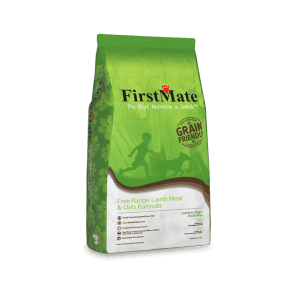

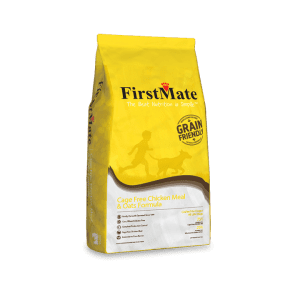

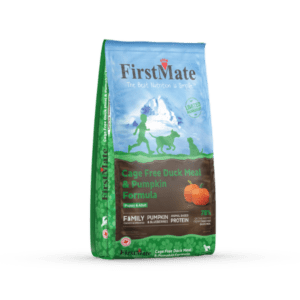

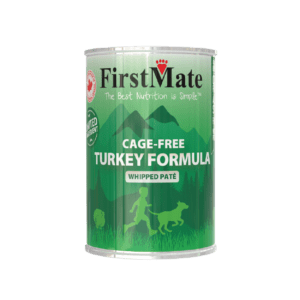

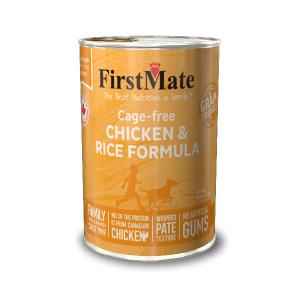
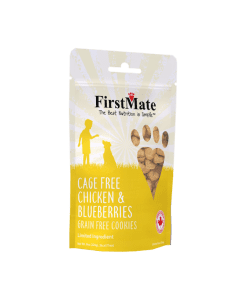
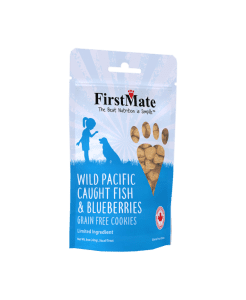
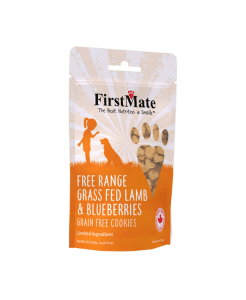

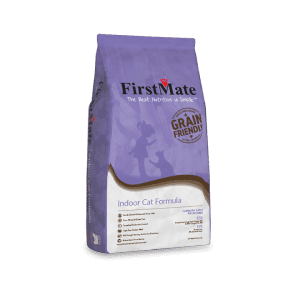

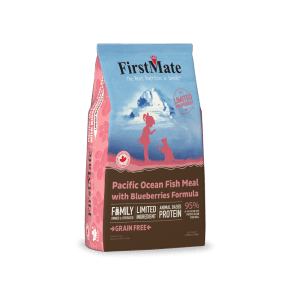
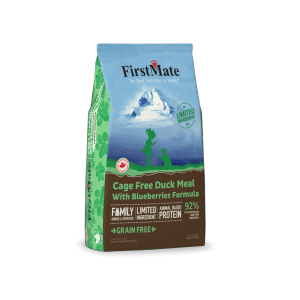
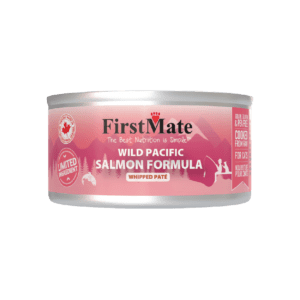
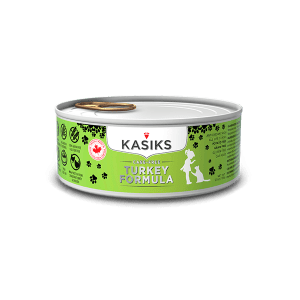
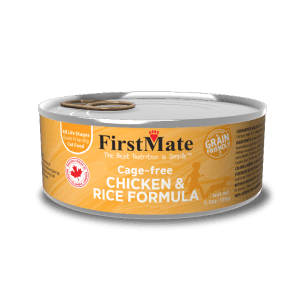


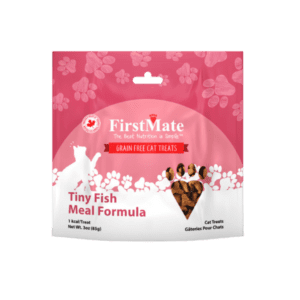
This is still too high for diabetic cats. Cats are pure carnivores. The potato and the kale, which interferes with thyroid function, are not healthy for cats, especially older cats. Thyroid malfunction is very common in older cats, as is diabetes.
Compared to dogs, cats are more obligate carnivores. Our FirstMate kibble and canned products would be considered low to moderate carbohydrate diets to meet the requirements of cats for a high meat-based diet. For our canned products, the average proportion of calories from carbohydrates (versus protein and fat) is 17% (ranging from 10-25%); many veterinarians recommend less than 15% for diabetic pets that require medical diets. Kibble products in general will tend to have higher carbohydrates since carbohydrates are an important component for the structure and taste of an extruded product. Our kibble has an average of 22% of the calories from carbohydrates. These are acceptable carbohydrate levels for healthy cats and are well balanced with appropriate protein and fat levels (Verbrugghe et al. 2012). For reference, most kibble products on the market fall between 20-40% calories from carbohydrates, and some are as high as 55%.
The concern with kale is the presence of goitrogens that can interfere with the uptake of iodine, thereby impacting thyroid function; studies that detected these impacts typically fed animals a diet with a very large inclusion of kale (sometimes kale was the only food provided to the animal). We include a small amount of kale as a natural source of Vitamin K. This amount of kale will not impact thyroid function.
We hope this helps to address your concerns.
Verbrugghe A, Hesta M, Daminet S, Janssens GPJ. 2012. Nutritional modulation of insulin resistance in the true carnivorous cat: a review. Critical Reviews in Food Science and Nutrition 52:177-182.
Sincerely,
Wendy Vandersteen, PhD
Manager of Research and Development
Hello Wendy, I read this post and please answer my question. What is the amount of phosphorus in FM Control formula and FM Original in EU feed? I can’t find this number anywhere. If you have the full table of analytical ingredients including the numbers, I would be very grateful. I am dealing with kidney problems in my dog. Thank you Dora
I am sorry to hear about your dog’s kidneys issues, and appreciate your interest in FirstMate to support your dog’s health and well-being.
It is important to note that our company does not manufacture medically specific diets. Although our products have been used successfully in the past in managing certain medical conditions, we recommend customers speak to their veterinarian before changing diets when a medical condition is of concern.
Our lowest phosphorus diet would be our Pacific Ocean Fish Senior / Weight Management formula. On a dry matter basis, our Pacific Ocean Fish Weight Management / Senior Formula has an average phosphorus of 1%. Based on historical data, phosphorus could deviate by 0.2%. Your veterinarian will need to advise you if that is an appropriate amount of phosphorus for your dog.
I hope this helps, and please let me know if there is any further information I can provide to you or your veterinarian to determine if this formulas will be suitable for your dog. I will also reach out to you by email so that you can contact me directly if you have further questions.
Sincerely,
Wendy Vandersteen, PhD
Manager of Research and Development
I bought the dry food today for my diabetic cat bcuz I don’t want to put him on insulin and want to see if changing his diet helps , as he will be coming off of purina one weight management and I’ve heard good things from first mate that this can help regulate his glucose and blood sugar , is it true? I have the blueberry one
Hello Mack,
We are sorry to hear about your cat’s issues with diabetes and appreciate your interest in FirstMate to support his health and well-being.
It is first important to note that our company does not manufacture medically specific diets. Although our products have been used successfully in the past in managing certain medical conditions, we recommend customers speak to their veterinarian before changing diets when a medical condition is of concern.
Our Pacific Ocean Fish Meal and Blueberries formula could be an option for you; this formula is 42% protein and 17% carbohydrate as fed (47% protein and 19% carbohydrate on a dry matter basis). It would be considered a low-glycemic option. However, compared to the diet that you were feeding, this diet has a higher caloric value and therefore it will be important to regulate daily food rations. I’d be happy to provide some feeding guidelines for you.
Our Wild Pacific Salmon canned formula may also be a good option to incorporate into his diet. It is 11% protein and 5.8% carbohydrate on an as fed basis (50% protein and 26% carbohydrate on a dry matter basis).
Don’t hesitate to reach out directly if there is any further information I can provide to you or veterinarian so you can determine if these formulas would be suitable.
Sincerely,
Wendy
Help please. I need a low Glycemic dog food that contains grain and chicken is NOT the number one protein in the food. My 10 year doberman is diabetic. Chicken always seems to dry out her skin. And this past month she developed congestive heart failure. This our vet has advised to not feed her a grain free food. Would FirstMate™ Grain Friendly Wild Pacific Caught Fish & Oats Formula Dog Food, work for what we are looking for? And is it possible to post a list of the Glycemic for your foods? Thank you for your help. Sincerely Bob Mattson
Hello Bob,
Thank you for your consideration of FirstMate to support the health and well-being of your Doberman.
The Grain Friendly Wild Caught Fish and Oats would be a great option for your dog based on your specified needs. Although the glycemic load of our Grain Friendly line at 19 is higher than our KASIKS line (10) and our grain free line (14), it is still below 20 and considered low glycemic.
The fish meal is also a great natural source of taurine, which will help support heart health. The omega 3 fatty acids in the fish will also support skin and coat health.
Best wishes,
Wendy
Wendy Vandersteen, PhD
Manager of Research and Development